A Composite Model of Wound Segmentation Based on Traditional Methods and Deep Neural Networks
- PMID: 29955227
- PMCID: PMC6000917
- DOI: 10.1155/2018/4149103
A Composite Model of Wound Segmentation Based on Traditional Methods and Deep Neural Networks
Erratum in
-
Corrigendum to "A Composite Model of Wound Segmentation Based on Traditional Methods and Deep Neural Networks".Comput Intell Neurosci. 2018 Sep 12;2018:4967290. doi: 10.1155/2018/4967290. eCollection 2018. Comput Intell Neurosci. 2018. PMID: 30275821 Free PMC article.
Abstract
Wound segmentation plays an important supporting role in the wound observation and wound healing. Current methods of image segmentation include those based on traditional process of image and those based on deep neural networks. The traditional methods use the artificial image features to complete the task without large amounts of labeled data. Meanwhile, the methods based on deep neural networks can extract the image features effectively without the artificial design, but lots of training data are required. Combined with the advantages of them, this paper presents a composite model of wound segmentation. The model uses the skin with wound detection algorithm we designed in the paper to highlight image features. Then, the preprocessed images are segmented by deep neural networks. And semantic corrections are applied to the segmentation results at last. The model shows a good performance in our experiment.
Figures


















Similar articles
-
Fully automatic wound segmentation with deep convolutional neural networks.Sci Rep. 2020 Dec 14;10(1):21897. doi: 10.1038/s41598-020-78799-w. Sci Rep. 2020. PMID: 33318503 Free PMC article.
-
An Intelligent Diagnosis Method of Brain MRI Tumor Segmentation Using Deep Convolutional Neural Network and SVM Algorithm.Comput Math Methods Med. 2020 Jul 14;2020:6789306. doi: 10.1155/2020/6789306. eCollection 2020. Comput Math Methods Med. 2020. PMID: 32733596 Free PMC article.
-
The effects of different levels of realism on the training of CNNs with only synthetic images for the semantic segmentation of robotic instruments in a head phantom.Int J Comput Assist Radiol Surg. 2020 Aug;15(8):1257-1265. doi: 10.1007/s11548-020-02185-0. Epub 2020 May 22. Int J Comput Assist Radiol Surg. 2020. PMID: 32445129
-
Machine learning and image analysis in vascular surgery.Semin Vasc Surg. 2023 Sep;36(3):413-418. doi: 10.1053/j.semvascsurg.2023.07.001. Epub 2023 Jul 7. Semin Vasc Surg. 2023. PMID: 37863613 Review.
-
Deep Learning Approaches Towards Skin Lesion Segmentation and Classification from Dermoscopic Images - A Review.Curr Med Imaging. 2020;16(5):513-533. doi: 10.2174/1573405615666190129120449. Curr Med Imaging. 2020. PMID: 32484086 Review.
Cited by
-
Automated wound segmentation and classification of seven common injuries in forensic medicine.Forensic Sci Med Pathol. 2024 Jun;20(2):443-451. doi: 10.1007/s12024-023-00668-5. Epub 2023 Jun 28. Forensic Sci Med Pathol. 2024. PMID: 37378809 Free PMC article.
-
Development and validation of interpretable machine learning models for postoperative pneumonia prediction.Front Public Health. 2024 Dec 11;12:1468504. doi: 10.3389/fpubh.2024.1468504. eCollection 2024. Front Public Health. 2024. PMID: 39726646 Free PMC article.
-
Image segmentation using transfer learning and Fast R-CNN for diabetic foot wound treatments.Front Public Health. 2022 Sep 20;10:969846. doi: 10.3389/fpubh.2022.969846. eCollection 2022. Front Public Health. 2022. PMID: 36203688 Free PMC article.
-
Automated wound care by employing a reliable U-Net architecture combined with ResNet feature encoders for monitoring chronic wounds.Front Med (Lausanne). 2024 Jan 31;11:1310137. doi: 10.3389/fmed.2024.1310137. eCollection 2024. Front Med (Lausanne). 2024. PMID: 38357646 Free PMC article.
-
Current status, challenges, and prospects of artificial intelligence applications in wound repair theranostics.Theranostics. 2025 Jan 2;15(5):1662-1688. doi: 10.7150/thno.105109. eCollection 2025. Theranostics. 2025. PMID: 39897550 Free PMC article. Review.
References
-
- Bhandari A. K., Kumar A., Chaudhary S., Singh G. K. A novel color image multilevel thresholding based segmentation using nature inspired optimization algorithms. Expert Systems with Applications. 2016;63:112–133. doi: 10.1016/j.eswa.2016.06.044. - DOI
-
- Yadav M. K., Manohar D. D., Mukherjee G., Chakraborty C. Segmentation of chronic wound areas by clustering techniques using selected color space. Journal of Medical Imaging and Health Informatics. 2013;3(1):22–29. doi: 10.1166/jmihi.2013.1124. - DOI
-
- Wang C., Yan X., Smith X., et al. A unified framework for automatic wound segmentation and analysis with deep convolutional neural networks. Proceedings of the 2015 37th Annual International Conference of the IEEE Engineering in Medicine and Biology Society (EMBC '15); August 2015; Milan, Italy. pp. 2415–2418. - DOI - PubMed
MeSH terms
LinkOut - more resources
Full Text Sources
Other Literature Sources
Medical

